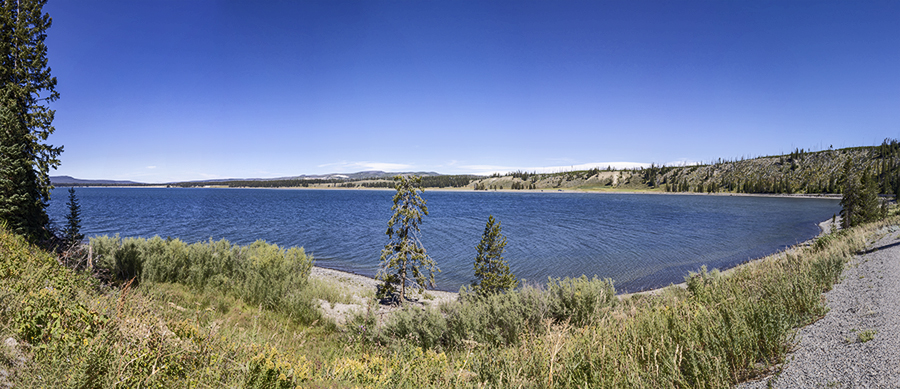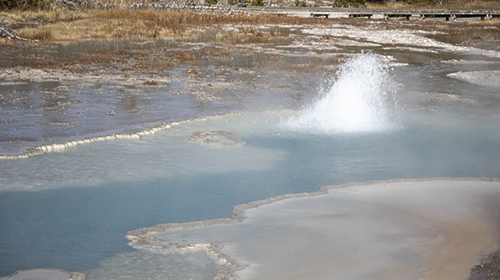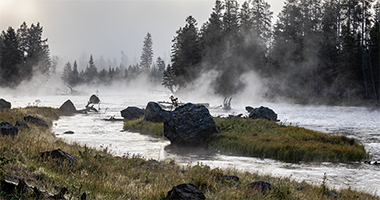Yellowstone Water

When you visit Yellowstone, you will enjoy many sites that will impress you as individual features of Yellowstone. For years, I never really looked at their impact as a whole. It was "What a beautiful river scene." "Wow, that river is really raging, I've never seen it so angry." "Oh, this lake is just beautiful." "Wow, look at this beautiful blue pool!" "There goes Old Faithful again; isn't it a wonder?" If you stop and think about it, water is a predominant resource that makes up Yellowstone National Park.

Bison are walking along the edge of the Madison River, avoiding the snow.

Water is vital to Yellowstone's very existence and beauty and makes Wonderland wonderful. Did you know at least 7 rivers have their headwater in Yellowstone National Park? The Gallatin, Larmar, Madison, Snake, Shoshone, Clarks Fork, and Fall River all start in Yellowstone. The Yellowstone River headwater is just outside the Park, beginning at Younts Peak in the Teton Wilderness. Approximately 2,500 miles of running water come from some 1,000 rivers and streams.
Sidebar: Wonderland is what early visitors would call Yellowstone. If you have seen Yellowstone, I am sure you can understand why they called it that.
There are 600 ponds and lakes, of which only about 150 are named. Yellowstone Lake is the largest North American Lake with the highest elevation above 7,000 feet (2,134 meters). The actual elevation is 7,733 feet (2,356 meters). Lake Titicaca, at 12,507 feet (3,812 meters) in the Andean Altiplano, is the highest elevation large lake in the world. It is more than 120 miles long and 50 miles wide. Yellowstone Lake is about 20 miles (32.2 meters) long and 14 miles (22.5 meters) wide. The surface area is 132 square miles (342 kilometers2). The Lake has 141 miles (227 meters) of shoreline. Mary Bay, on the north edge of the Lake, is the result of the world's largest hydrothermal explosion. 13,800 Years ago, its 1.5-mile (2.6-kilometer) crater was created.



Being in the Rocky Mountain Range, Yellowstone National Park has a significant snowpack that feeds the rivers, streams, lakes, and ponds. The average annual snowfall is 150 inches (381 centimeters), but higher elevations can get twice that amount. Weather is an essential factor in Yellowstone's beauty. Who doesn't love a snowcapped mountain scene? Or put your feet in a cold mountain stream in the heat of summer? How about watching Old Faithful in the rain or snow? What a thrill when you know Old Faithful is erupting because you can hear it but can't see it due to falling snow.
That blinding snowfall snow or the rain from a springtime rain will melt and/or sink into the ground around the thermal features. It sinks down close to the hot spot underneath Yellowstone. Then it turns around and comes back up through one of the features, "plumbing system," to come out as an eruption, runoff, steam, or pool. This trip isn't a quick trip, either. Research shows that a round trip can take 100 to 1100 years to complete. So, as you enjoy the thermal features one day and get rained on, your 4-5 to 44-55 generations later will see the water you felt on your trip. (There are 4-5 human generations every 100 years.)
There are 10,000 hydrothermal features in Yellowstone, the most prevalent of which are hot springs. There are over 500 geysers in Yellowstone, each of which, when active, can release a large amount of water. For example, depending on how long Old Faithful erupts, usually 1.5-5 minutes, it will expel 3,400—8,000 gallons (12,870 or 302,833 liters) of water about every 90 minutes. At Midway Geyser Basin, Excelsior Geyser puts out 4,000 (15,142 liters) gallons of water a minute. While driving on the Grand Loop road by the geyser basins, you will see a lot of steam rising from the various features. When a cubic foot of water is heated to 212°F (100°C) and converted to steam, it will become 1,646 cubic feet of steam.


Water is essential for the life and vegetation of animals. Those animals we all love to watch and photograph. Water is a prominent and crucial feature and resource of Yellowstone. Dare I say? It is what makes Yellowstone Yellowstone.
One more essential water display of power and importance is waterfalls. There are over 290 waterfalls in the park. Click the link to the waterfalls page to start your waterfall visit to 19 waterfalls in the park. Waterfalls Link.
















